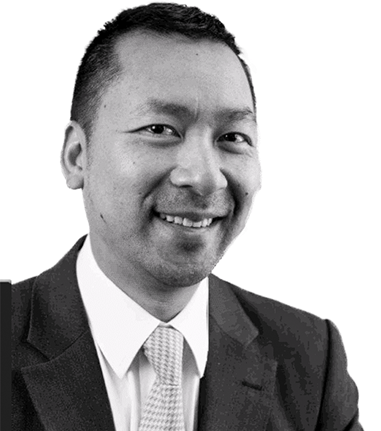
Modern medicine is moving increasingly towards a personalised, holistic approach to patient care. Yet can factors such as lifestyle and motivation have a truly transformative effect on post-surgical outcomes?
"The crucial thing to remember is that the most important person in deciding the success of this whole approach is the patient."
In as little as one century modern medicine has accelerated at an awe-inspiring rate. From mapping the human genome and pioneering prosthetics to revolutionising stem cell treatments and developing minimally invasive surgical techniques, science and technology have created a new paradigm in world health. Yet as we blur the lines between medicine, science and technology, we simultaneously recognise that the human experience drives this progress. It’s for humans we embrace progress and for individuals we pursue the promise of healthier lives. With this realisation comes a corresponding interest in so-called holistic healthcare: how can all our collective knowledge, rich data and advanced technologies come together to help one individual patient, on what may be the most important day of their life?
If this sounds like hyperbole, it’s worth considering the deeply personal nature of medicine. Lower Back Pain (LBP) for example, is thought to affect around 10% of the global population, ranked as the highest cause of disability in the Global Burden of Disease 2010 Study1. Yet whatever the underlying cause or condition, back pain is deeply personal to each patient, depending on its severity, the patient’s perception of pain and their lifestyle expectations. It’s also one of the most commonly misunderstood and under-diagnosed ailments.
For a patient who has lived with LBP – or indeed any other debilitating health condition – the prospect of surgery can seem like the promise of a miracle cure. After potentially years of pain, uncertainty, false starts and well-meaning advice, surgery offers a scientific, medical intervention. Many patients, and even some medical professionals, see only a transformative event, and not one major step on a very long and personal journey back to health.
Holistic healthcare, personalised healthcare, patient-focused healthcare – what these terms collectively attempt to capture is the full spectrum of the patient experience. Study after study suggests that surgery does not offer a ‘big bang’ miracle cure, but rather should be viewed as part of a much broader care package, in which the patient takes centre stage. There are multiple components in the ‘holistic’ approach, including:
- Prehabilitation: The pre-operative lifestyle intervention focusing on optimising patient health pre-surgery, for example through weight loss, smoking cessation and abstinence from alcohol or drug use.
- Rehabilitation: Focuses on the provision of follow-up medical care, including physiotherapy, pain management, dietary advice and counselling.
- Patient empowerment: An approach that aims to improve two-way communication with the patient, both through the delivery of accurate and appropriate information and a willingness to listen to and address patient concerns. Psychological factors such as a patient’s psychological state and sense of motivation and positivity are also key.
- Support services: ‘Holistic’ approaches to health depend on the patient having access not only to a personal support network comprising friends, family, carers and medical professionals, but to all related services seamlessly sharing information and data to enhance the patient’s overall experience.
Preparation is key
Of course, ‘holistic’ health is a broad and to some extent ambiguous term, and some of its key concerns, such as a patient’s mental attitude, are difficult to accurately and objectively measure. However there are studies which quantify the benefits, or at least point to some encouraging results.
A randomized clinical trial2 undertaken by researchers at the University of Copenhagen provided compelling evidence that prehabilitation and early rehabilitation resulted in lower costs for healthcare providers and faster recovery times for patients. The study, Prehabilitation and early rehabilitation after spinal surgery: randomized clinical trial, focused on the rehabilitation of 60 patients scheduled for lumbar fusion surgery in the University of Copenhagen orthopaedic surgery department.
Twenty-eight patients were randomly selected by computer to receive a prehabilitation intervention consisting of an intensive exercise programme, the optimization of the analgesic treatment and the provision of protein drinks, in the two months prior to surgery. Post-surgical rehabilitation included balanced pain therapy with self-administered epidural analgesia, doubled intensified mobilization and protein supplements. The remaining 32 patients were provided only with standard care.
The study focused on the outcomes of postoperative stay, complications, functionality, pain and satisfaction. It found that patients receiving prehabilitation and early rehabilitation hit post-operative goals sooner, resulting in a shorter post-operative stay, returned to work sooner (77 days compared with 88) and soaked up less primary care. The researchers also calculated that while direct costs per patient were higher in the preoperative period due to the cost of the prehabilitation programme, the integrated programme was 1,625€ less costly per patient compared to the standard care programme. These results suggest that prehabilitation is potentially of great benefit to the patient, and may also carry significant financial incentives for healthcare providers.
Less pain more gain
In the case of pain management, a broad and compelling body of international research argues that the medical profession’s approach to pain relief lacks the level of sophistication one might expect in 21st century healthcare. An article in the Yale Journal of Medicine3 postulates that while pain is closely tied to surgical outcome, and is one of the three most common causes for late discharge, the clinical reality is far from satisfactory, with medical teams overlooking the multidimensional nature of pain. They conclude:
“With the many advances in pain management for the surgical patient, surgeons and pain care providers have myriad choices of analgesic pharmacotherapy and analgesic techniques to choose from.... However, many factors must be considered before deciding on the type of pain therapy to be provided to the surgical patient. These include the patients’ co-morbid conditions, psychological status, exposure to analgesic therapies, and the type of surgical procedure… In the future, genetically informed “personalized medicine” may become a reality even for acute pain management.”
Joined-up services
Of course, the challenge for healthcare providers is two-fold: finding the resources to deliver this joined-up approach to healthcare and linking up services that have historically been separate. Some progress can already be seen internationally, with Washington, USA, launching a Strong for Surgery initiative4 in a bid to drive surgical quality improvement (QI). The initiative aims to create a ‘learning healthcare system’ which maximises interactive tools, checklists to optimize health and strategies to enhance communication. "This is an opportunity to engage patients in the process of asking important questions, rather than passively moving through the system," Dr Varghese, director of thoracic surgery at the University of Washington's Harborview Medical Center in Seattle told the Washington Post.
Meanwhile in the UK, the National Health Service Enhanced Recovery Programme5 takes a four-prong approach to improving long-term patient care, focusing on: preoperative assessment, planning and preparation, reducing physical stress of operation, structured approach to post-operative and peri-operative management including pain, and early mobilisation.
As the medical profession continues to evolve, it seems inevitable that the direction of travel will continue towards one of holistic, patient-focused health and social care.

Patient first: how can holistic healthcare enhance recovery?
Dr YH Yau, neurosurgeon and spinal surgeon at the Royal Adelaide Hospital and The International Spine Centre, Australia, shares his perspective on the impact that physiotherapy, health optimization and pain control can make on post-surgical recovery.
Dr YH Yau is a consultant neurosurgeon and spinal surgeon, holding specialty fellowships with the Edinburgh and Australasian Royal Colleges of Surgeons. He is also a fellow of the Faculty of Pain Medicine, Australian & New Zealand College of Anaesthetists. Dr Yau’s current clinical academic appointment is with the Department of Spinal Surgery, Royal Adelaide Hospital, and the University of Adelaide in Australia. His multidisciplinary private practice is with The International Spine Centre. With AOSpine, he serves as the Chair of the Education Committee for Asia Pacific.
To what extent do you view surgery as one part of the healing process for patients?
In my experience, patients who embrace a broader programme of care have a much better post-surgical outcome than those who may view surgery as a ‘miracle cure.’ The most important thing in patient care is goal setting – what is the patient hoping for at the end of the process? Managing expectations are key to that, and tailoring care to the individual needs and expectations of each patient. For example, you might have a patient in the armed forces who needs to be fully fit, an athlete whose sport is their priority, someone who just wants relief from the condition so they can go out with their family, or an elderly person who wants to retain their independence. That’s how you match how extensive the surgery should be. In that context, ‘holistic’ care as it’s called, is about looking at the whole person and how the right combination of diet, exercise, physiotherapy and pain relief can help them to reach their recovery goals.
Which of these factors do you find have the biggest impact on post-surgical outcomes?
Overall health optimization prior to surgery is of great importance. Unfortunately, many of the patients I see have become deconditioned because of their impairment or pain. They might be gaining weight, smoking, and taking more medications, such as opiate pain relief. All of these factors can compound the situation. If a patient reaches us in that clinical state and we are able to intervene to optimize their overall health, it sometimes means they won’t need surgery at all, and if they do, the outcome tends to be better.
However, when a patient’s overall health deteriorates to a certain point it can be difficult to turn it back again through conservative measures, and what you’re left with might be surgery as a physical, structural treatment. It’s important to note however that function isn’t the same as structure. Sometimes we have patients with terrible looking scans who don’t need surgery, and some patients with unremarkable scans, who are greatly impaired. That’s because there are many things you don’t see on a scan – particularly pain, and how the patient experiences it.
How important is appropriate pain management in the patient’s recovery?
We know that if pain relief is well controlled prior to surgery the patient will have less perioperative and postoperative pain issues, and so can mobilize earlier. It’s also important that we opt for the right kind of pain relief. Commonly we see a lot of opiate medication, but at some point opiates can lead to pain sensitization, which worsens the problem for the patient. It’s a delicate balance. If we’re looking at treating nerve pain through surgery on the neck or back, selecting the right medications gives us better control for post-operative recovery. However, if the surgery is an attempt to treat a more generalized pain, understanding the psychological experience of the patient is key in how well they will do.
How important is it that the patient benefits from a strong support network, not only in terms of their medical team, but also their carers and family?
It’s very important. As clinicians, when we see a patient alone, they will often go away and forget the majority of the conversation. We might feel that the patient has been well informed, but then at the end of the surgery they might tell us ‘My leg feels better but my back is still very painful.’ This is despite our consultation explaining that the primary aim of the surgery was to help with nerve pain in the leg. For that reason I try not only to get informed consent – where the patient is advised of the risks – but also effective consent, so the patient can relate back to me exactly what we discussed in the consultation. Having support from the family as part of that consent process is important, and it’s also invaluable for the patient to have people who know what they’re going through and what the expected outcomes are after they return home. They provide not only physical support but also help the patient to work through why they have reached this stage, and to maintain motivation for recovery. To give just one example, in the case of smoking it often takes a whole family effort to help the patient to quit. The same is often true of diet and weight optimization.
Do hospitals offer sufficient joined-up services to maintain this holistic approach?
The services available are varied depending on the country, and within the country depending on whether the healthcare provision is public or privately funded. Resources in the public services are often under-resourced, so the amount of preparation time with the patient prior to surgery is quite limited and the waiting time for procedures is often long. This means by the time the patient is scheduled for surgery it is often too long to turn the clock back and work to optimize their health. There is generally a routine follow-up but it tends to be specific and surgical in its focus. The private healthcare system is similar, but patients are likely to be seen a little earlier which provides more opportunity for prehabilitation prior to surgery.
Do you think there’s a general shift towards holistic healthcare and if so is it necessary?
Holistic healthcare looks at the whole person, and it’s exactly what we strive for. There are of course some limitations – depending on where you work you might have limited access to resources, and often the patient path is fragmented. A patient might be able to access a dietitian, a counsellor, a pain management specialist and a surgeon, but unfortunately it’s often very broken up and spaced apart. At The International Spine Centre we aim to get all the experts in one place so we can manage people in that integrated and more complete fashion. The crucial thing to remember is that the most important person in deciding the success of this whole approach is the patient. They need to feel completely invested in the process and understand what we’re all working towards. The aim is participatory care for the patient all the way through, and we’re working towards an understanding that surgery is only one small part of their journey.
- Hoy D 2014 ‘The global burden of low back pain: estimates from the Global Burden of Disease 2010 study’ http://ard.bmj.com/content/73/6/968.full
- Nielson P.R. 2014 ‘Prehabilitation and early rehabilitation after spinal surgery: randomized clinical trial’. http://cre.sagepub.com/content/24/2/137.short
- Vadivelu N, Mitra S, Narayan D 2010. ‘Recent Advances in Postoperative Pain Management’ Yale Journal of Biology and Medicine. http://www.ncbi.nlm.nih.gov/pmc/articles/PMC2844689/
- http://www.becertain.org/strong_for_surgery
- http://www.institute.nhs.uk/quality_and_service_improvement_tools/quality_and_service_improvement_tools/enhanced_recovery_programme.html

